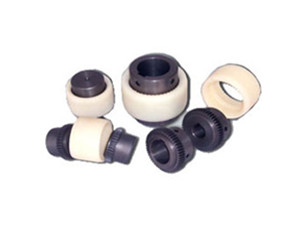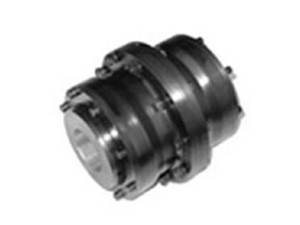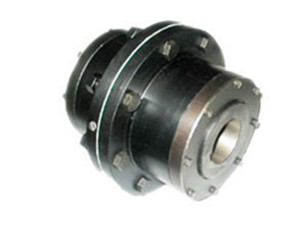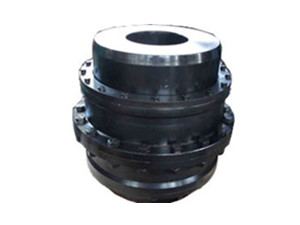The elastic sleeve of the new elastic pin coupling is deformed by compression during operation
The new type of elastic pin coupling makes up for the current standard HL type elastic pin coupling in the manufacture, assembly and maintenance of the shortcomings; especially to solve the problem that the bolts may be broken due to the wet roadway of the underground coal mine conveyor during the maintenance process. The problem in the thread hole ensures the continuity and reliability of the coal mine flow-through production line.
The elastic pin coupling is simple in structure, easy to manufacture, does not require lubrication, does not need to be bonded with metal vulcanization, it is convenient to replace the elastic sleeve, does not need to move the half coupling, and has a certain degree of compensation for the relative deviation of the two shafts and vibration damping.The work of the elastic sleeve is compressed and deformed. Because the thickness of the elastic sleeve is thin, the volume is small, and the elastic deformation is limited.Therefore, although the elastic sleeve pin coupling can compensate the axis displacement and elasticity, the allowable compensation amount for the axis displacement is less, and the elasticity is weak.The elastic sleeve pin coupling relies on the locking force of the pin group to generate the frictional moment on the contact surface, and compress the rubber elastic sleeve to transmit the torque.It is suitable for small and medium power shafting transmissions with good rigidity, high centering accuracy, low impact load, and low vibration reduction requirements. The elastic pin coupling uses a column with an elastic sleeve (rubber material) at one end. The pin is installed in the flange hole of the coupling halves to realize the coupling of the coupling halves.The elastic sleeve pin coupling used to be my widely used coupling.As early as the late 20s, it has been formulated as a standard for the Ministry of Machinery. JB50-08 elastic ring pin coupling is our standard coupling.
HL型-弹性柱销联轴器已列为标准GB5014-85,适用于各种机械联接两同轴线的传动轴,通常用于动频繁的高低速运动。工作温度为-20 ~+80℃;传递公称扭矩为4020000N.m。弹性柱销联轴器具有较大结构简单、合理,维修方便、两面对称可互换,寿命长,允许较大的轴向窜动,具有缓冲、减震、耐磨等性能。半联轴器采用精密铸造,铸铁HT20-40、铸钢ZG35Ⅱ,轴孔和键槽采用拉制成型,柱销采用MC尼龙b制成。
The elastic pin gear coupling is a pin made of a number of non-metallic elastic materials, which is placed in the flange hole of the two halves of the coupling, and the two halves of the coupling are connected by the pin. The coupling has a simple structure , Easy to manufacture, easy to assemble, disassemble and replace the elastic element, without moving the two halves of the coupling.The material of the elastic element (column pin) is generally nylon, which has the ability to slightly compensate for the offset of the two axes. The elastic part is sheared when working, and the working reliability is poor. Working conditions with high reliability requirements.
The elastic pin gear coupling has the following characteristics:
(1) The transmission torque is large. At the same torque, the rotation diameter is mostly smaller than that of the gear coupling, and the volume is lighter. It can partially replace the gear coupling.
(2) Compared with the gear coupling, the elastic pin gear coupling has a simple structure, fewer components, and is more convenient to manufacture. It does not require a gear processing machine tool.
(3) Convenient maintenance and long service life. The nylon pin can be replaced by removing the baffle.
(4) The nylon pin is a self-lubricating material, which does not need lubrication, which not only saves lubricating oil, but also purifies the working environment.
(5) Poor vibration reduction and high noise.The elastic pin gear coupling has the performance of compensating the relative deviation of the two shafts to a certain extent. It is suitable for medium and high power transmission, and is not suitable for working parts that have certain requirements for vibration reduction and strict control of noise.
relevant information
- Function of coupling
- Treatment method and lubrication of gear coupling failure
- The reason why plum coupling is often damaged
- The difference between star coupling and plum coupling
- The structure and advantages of JQ type clamp coupling
- How to install and connect the coupling
- Installation technology of drum gear coupling
- The keyway type and code of the shaft hole of the diaphragm coupling
Ranking of similar articles
- Function of coupling
- Treatment method and lubrication of gear coupling failure
- The reason why plum coupling is often damaged
- The difference between star coupling and plum coupling
- The structure and advantages of JQ type clamp coupling
- How to install and connect the coupling
- Installation technology of drum gear coupling
- The keyway type and code of the shaft hole of the diaphragm coupling
- Specifications and parameters of plum coupling
- Advantages of elastic pin coupling





